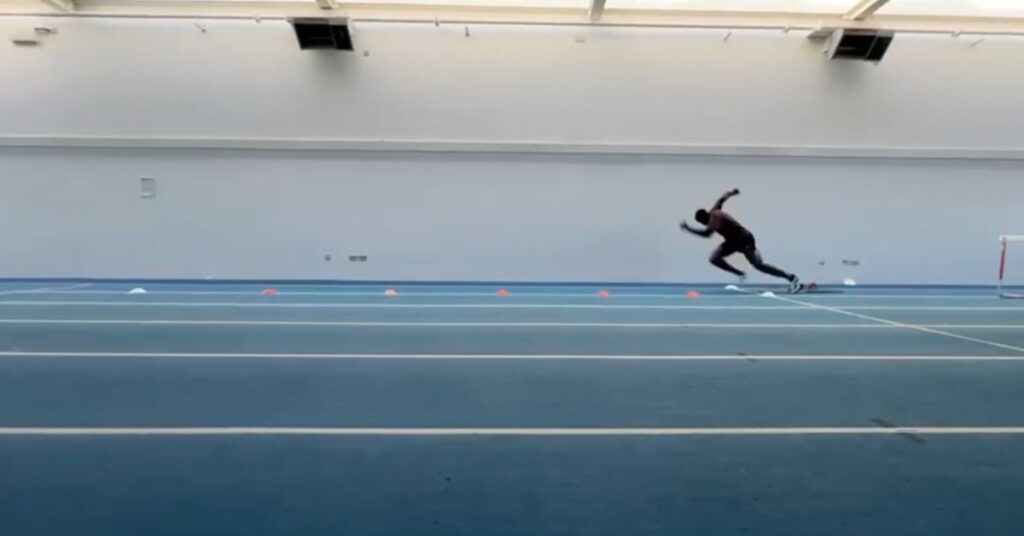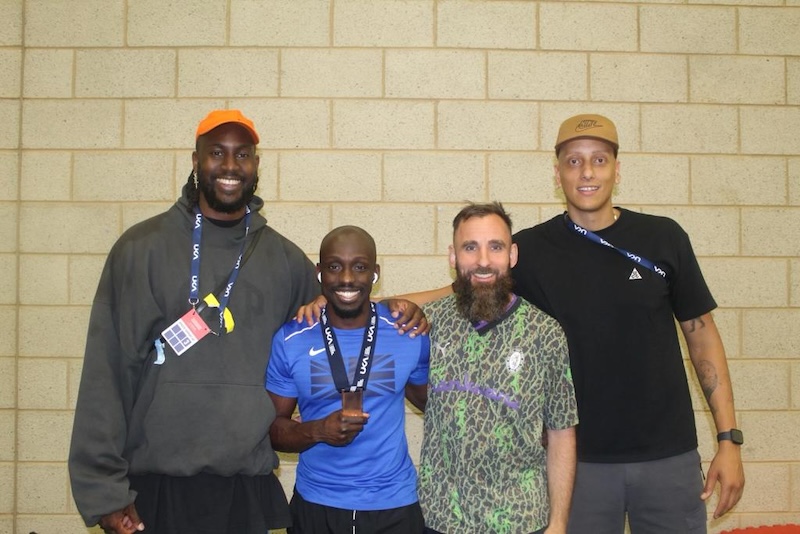
Steve Fudge is the Head Coach of FudgeLdnProject, a professional sprints group located at the Lee Valley Athletics Center in London. He specializes in individualized track coaching complemented by world-class therapy and physical preparation. With a career spanning more than 15 years as a sprint coach, Steve has guided athletes to impressive milestones, including Sub 10, Sub 20, Olympic, Paralympic, World, European, Asian, and Commonwealth medals. Beyond coaching, Steve actively contributes to the coaching community by providing mentorship to aspiring coaches worldwide.
Freelap USA: You entered sprint coaching from a more general strength and conditioning background. What did that experience provide you with that you may otherwise have missed?
Steve Fudge: As a strength and conditioning coach, you learn anatomy, programming, how to teach different groups, etc., all as part of a multidisciplinary team working with the sport-specific coach and the medical team, among others. This experience allowed me to learn what kind of setting I wanted to work in, and I learned that I preferred working with smaller groups and in individual sports. As an S&C coach, I felt my job was essentially to develop athletes who were resilient and had the capacity to carry out the sport-specific head coach’s programming.
As an S&C coach, I felt my job was essentially to develop athletes who were resilient and had the capacity to carry out the sport-specific head coach’s programming. Share on XI think this experience demonstrated to me that it was the sport-specific coach who would make or break the athlete in terms of success, and therefore, their programming needs to be absolutely right! The S&C coach supports this by developing athletes who are able to carry out higher-quality sport-specific practice reps and do more of them. Aspects such as strength around the hips and an anatomy that allows the athlete to maintain the correct posture can serve to elevate the efficacy of the sport-specific training.
I learned the value of building a strong relationship with the sport-specific coach, so I could understand what was needed from me as an S&C coach and how best to work with the athletes. A specific example of this might be that, as an S&C coach, I found my sequencing from general to specific needed to take place a bit earlier than it did for the sport-specific training.
Essentially, I was preparing the athletes for the upcoming phase of sports-specific training, so I had to provide them with some exposure to the kind of stimulus they may expect in their upcoming training block and set them up with the qualities they needed so that they could take advantage of the sport-specific work. For example, if I know the athletes are about to enter a six- to eight-week block where high-velocity sprinting is the main focus, I want to make sure I have developed their power and elasticity prior to that so they can maximize the benefit from the high-velocity training block.
Video 1. British sprinter Eugene Amo Dadzie training in an outdoor session.
Additionally, as an S&C coach, you want to ensure that there’s no interference between the work you’re prescribing the athlete and the sport-specific work they’re doing. If they’re doing particularly neurally demanding work on the track, then any neurally demanding work in the weight room would likely need to be limited.
Freelap USA: You’re quite well known for teaching technical concepts to your sprinters. I’m sure the methods you use to guide the athletes toward the positions you want to see vary, but what concepts and positions do you see as integral to a high level of sprint performance?
Steve Fudge: What I’m looking for in a 100-meter sprinter is an athlete who moves down the track in or around 45 steps. Within each of those steps, they need to have a lengthening moment and a folding moment, and this sequence needs to be performed in such a way that it doesn’t disrupt their momentum. Therefore, each ground contact needs to be impactful, but after that contact, the athlete needs to rearrange their positions so their next ground contact can also be impactful.
Video 2. Eugene Amo Dadzie’s acceleration posture.
One of the biggest challenges is that the athlete needs to strike the ground hard, and there needs to be a moment where the hip, knee, and ankle all violently extend. However, to keep momentum, the athlete can’t spend too long lengthening, as it will slow things down by potentially bringing the shoulders back and forcing a landing that generates higher braking forces.
One of the things I think the best ‘top-end’ sprinters do well is consistently keep the action in the space just in front of them. Share on XThis can have a knock-on effect of disrupting the rhythm and causing the athlete to force frequency. Therefore, there is the need to get the leg back in front, almost a triple-flexion moment, in preparation for the next step. One of the things I think the best “top-end” sprinters do well is consistently keep the action in the space just in front of them. It appears the best have the ability to pre-program their posture to ensure that each step is relevant, and they do an excellent job of rearranging their shapes after the previous contact to ensure they are ready for the next.
Sprinting is very much a balancing act and needs to be harmonic. Elite sprinters have high velocities because they have high frequencies, which is what happens in the air, and they have high velocities because they have long stride lengths, which is a result of what happens on the ground. As a sprinter, we want both those metrics to be high, and it can be somewhat paradoxical because emphasizing one will rob the other.
One of the things I look for to ensure that frequency isn’t rushed and there’s enough time for stride length to be generated is that when the foot is on the ground, the pelvis must pass over the foot. After this point, the job is already done, and the athlete can recover the leg, “move to the front,” and set up for the next contact. If there’s too much emphasis on extension, the athlete can find themselves in a situation where they don’t have enough time at the front to set up the next step, and the rhythm can break.
Freelap USA: Technology is becoming more and more accessible to sprint coaches to both develop and track performance. What technologies do you use when preparing your sprinters?
Steve Fudge: As coaches, we adapt to our situation, whether that be with or without much access to technology. I’ve gone through one stage of my career where I had good access to technology, and we got good results. When I was based in Loughborough and working for British Athletics, we had access to OptoJump and Laveg—both tools that could provide instant feedback throughout the sprint session.
The information could be used to reinforce what I saw, and I tried to combine the metrics with mechanics and the coach’s eye, which is where I see the implementation of technology as being most valuable. For example, I may detect a change in rhythm at “x” meters into a run, and the data may show that there was a change in stride length and stride frequency at that same point as well, or there was a plateau in acceleration. This, therefore, helped to guide the process and enabled us to be more confident about which point in the run we needed to work on.
We would use the Laveg as a way to guide and assess the session objective. For example, I could ask an athlete to build to a top speed at 65 meters, and the Laveg would help us determine whether that objective was met. It also allowed the athlete to equate what successful completion of the exercise felt like.
However, in my current situation—a private, independent group with no federation support or sponsorship— we have very little technology but still get good results. I currently use a whistle, a stopwatch, an overspeed band, and the camera app on my iPhone!
Video 3. British 100m sprinter Ojie Edoburun sprints from the whistle.
Technology is only as good as the practitioner, and as with many things, the information is only as valuable as your interpretation. Therefore, I think technology can enhance good coaching, but without that and effective programming, I don’t think technology alone can do the best job.
Technology is only as good as the practitioner, and as with many things, the information is only as valuable as your interpretation… I worry that too much data may interfere with my intuition. Share on XI think there’s a risk in implementing technology you don’t consistently have access to because it only provides a snapshot of the whole picture. This may cause you to panic unnecessarily based upon what is essentially an anomaly, but you’re unable to see that without the presence of consistent data. The risk is that now the coach overhauls the program and starts heading in a different metaphorical direction.
Data can be useful, but there’s a risk that too much data can interfere with my intuition or cause me to overthink things. Now, I don’t think this is the case for every coach, so it’s important for a coach to decide which pieces of information they believe to be important. Then, they need to go about ensuring they can access that information to guide their decision-making. Ultimately, much as every athlete is different, every coach is different, and they need to spend time developing their own way of doing things.
As coaches, we need to make lots of decisions, and sometimes in high-pressure scenarios. Therefore, it’s important to build a system that athletes have trust in and not just copy what someone else does, as they may not have faced the same situation that you’re in currently.
Freelap USA: I’ve heard you talk about a “health first” approach when coaching your athletes. Can you elaborate on the practical applications of this in your day-to-day practice? Can you provide an example of individualizing your programming to promote this philosophy?
Steve Fudge: You must get the programming right! We have the events we need to prepare for, and we have the individuals in front of us. It can be a challenge because you need to look at the person, then look at the “perfect” program you would implement to prepare someone to run that event, and then figure out a way to marry the two together.
If you want to stay healthy (which you should!), you need to pick the right type of training for that individual, then pace and progress it appropriately. As I said, fundamentally, the programming needs to be appropriate.
If I have a 60–100-meter type athlete, I sit down and map out the type of work, sessions, and progressions I think they need to do through general prep, specific prep, and into the competitive phase. I then look at the athlete and decide what I need to make that program work. Where does the program need to be trimmed or edited so it is still that program but now fits the individual?
It can almost be a case of fitting a round peg into a square hole, so it’s challenging! This can be assisted by having regular access to a good therapist and a good team to assist with prehab and rehab, but if the programming is off, none of that really matters.

We then need to keep in mind what must be done on a daily basis to remain on that pathway. If you end up in a situation where what you have planned for a given day no longer seems appropriate, you need to be flexible and make a good decision, and this requires discipline. It could be something like the athlete didn’t sleep well or a family issue has arisen, and it’s important to know that the whole plan won’t fall apart because this session isn’t done on a particular day.
Staying on the path, perhaps paradoxically, requires you to be open-minded and change the plan as you go in some cases. I think it was Mike Tyson who said that everyone has a plan until they get punched in the face, and as coaches, we all have plans until we meet our athletes and realize they’re human beings, not robots!
Freelap USA: As we’ve mentioned, your programming can be quite individualized based on what you see from the athlete. Can you provide a general guideline of how you set out your training week and a couple of examples to demonstrate what this looks like in practice?
Steve Fudge: In my experience, within general prep, sessions generally fit a nice, tidy arrangement, but once we get to specific prep, things get more chaotic, and I need to be more adaptable.
In general prep, though, we’ll have four technical units, four tempo units, and four gym units within each week. While the details may vary quite significantly depending on multiple factors such as time of year, health status, athlete profiling, etc., this is an example of what some sessions may look like for an athlete.
Video 4. Indoor training session with Eugene Amo Dadzie.
Monday:
Acceleration – 6–8×20–30m from various stances, such as starting from one block pedal.
Short tempo – 4x2x50m back-to-backs, 1–2 minutes’ rest.
Gym – Conditioning and capacity (less neurally intense; focused on movement patterns and conditioning).
Tuesday:
Transition – 4–6×35–50m over cones with about a 10-meter run-in. (I want six steps before the athlete reaches the first cone.).
Long tempo – 220m+110m, 200m+110m, 150m+110m.
Gym – Force and general strength (traditional strength, power, and elastic work).
Wednesday:
Off
Thursday:
Acceleration – Similar to Monday.
General fitness tempo – Individualized depending on what I think that athlete needs.
Gym – Conditioning and capacity (see Monday).
Friday:
Upright running – 2–4x55m over cones with an 18-meter run-in.
Medium tempo – 180m, rest 6 minutes, 150m, rest 5 minutes, 3×120 with 4 minutes’ rest.
Gym – Force and general strength (see Tuesday).
For more information on the gym units, please see the Freelap Friday Five interview with Jermaine Olason.
Since you’re here…
…we have a small favor to ask. More people are reading SimpliFaster than ever, and each week we bring you compelling content from coaches, sport scientists, and physiotherapists who are devoted to building better athletes. Please take a moment to share the articles on social media, engage the authors with questions and comments below, and link to articles when appropriate if you have a blog or participate on forums of related topics. — SF


Great article Steve. Enjoyed reading about an awesome collation of philosophies that have led to your successes.
I’m hoping that many coaches will stumble across this article and not dwell too much on the mass of information lying elsewhere on the many social media platforms.
Keep up the amazing work that you do!
very Informative article.